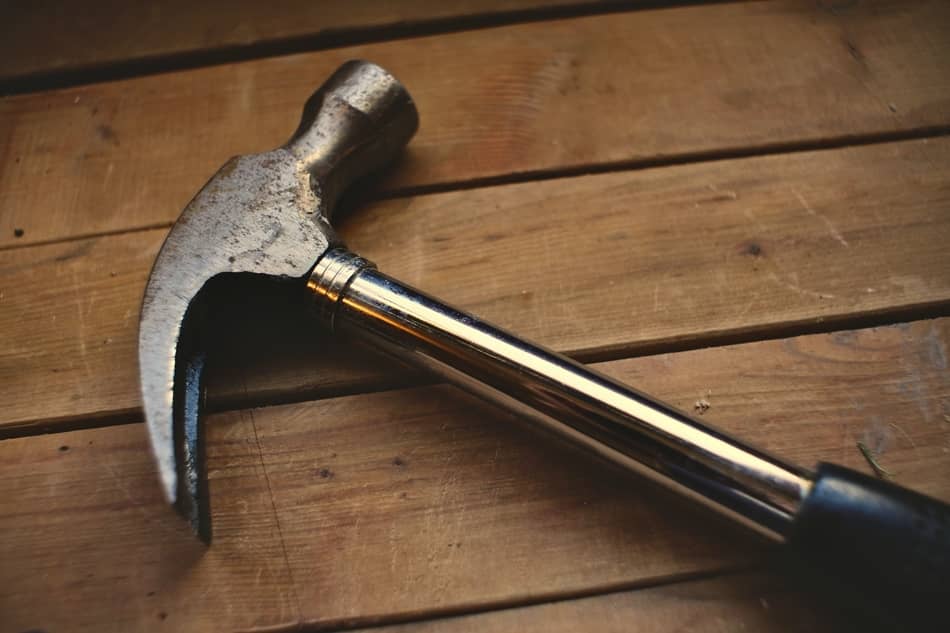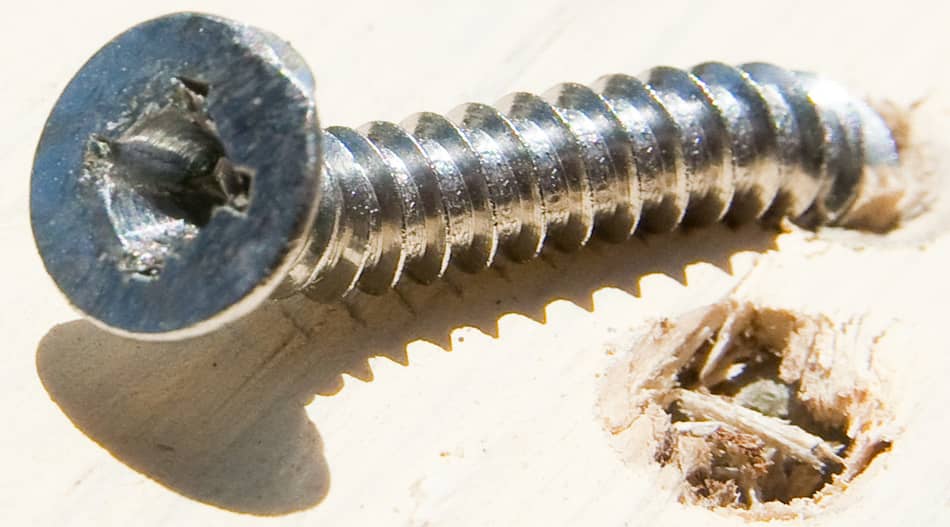If you’ve found yourself needing to do some DIY but don’t have a screwdriver or drill to drive in the screw, you may have been left wondering whether it’s possible to use a hammer instead. So what’s the deal, can you hammer in a screw?
It is possible to hammer in screws with the correct technique, but it is not recommended as it may damage the screw and the surface you are hammering the screw into. Hammering a screw may cause the thread to rip a large hole, which results in the screw falling out or not being secure enough to support any weight.
Let’s take a look at what could happen if you choose to hammer in a screw, how to do it the right way, and when it’s the best choice.

What happens if you hammer in a screw?
Usually, if you hammer in a screw then you will end up stripping either the screw or the hole or both – very similar to when you tighten a screw too much.
Screws are not really meant to be hammered in the same way as nails and hammering them in with force can often cause them to snap as they are not as strong as nails and therefore snap easier.
However, it is possible to hammer a screw into wood if you have enough force (and a big enough hammer), but you must take care not to damage your wall or injure yourself while doing it. Also, screws actually have a greater holding strength as their threads allow them to hold better than the smooth surface of a nail.
Is it a bad idea to hammer a screw into the wall?
It’s really not a good thing if you accidentally make a hole that is too big as the screw will not be secure and will just drop straight back out. If you end up with a hole that is too big it can cause serious damage to your wall that could cost you a lot of time and money if you have to repair it.
Therefore, it’s far better to have a screwdriver that is the right size before you attempt to set a screw into the wall. Alternatively, a power drill would also do the job so long as you used it at a low speed.
Tip: If you are putting a wall plug into the wall but don’t have the right tools to make a hole then you can use a screw instead. You can do this by hammering the screw in and then using some pliers to move the screw around to make the hole bigger. This means you can then put the wall plug into the hole you’ve just made and then put the screw in the wall plug.
Hammer in the screw the correct way
It is recommended by professionals to create a pilot hole first as it will prevent damage from being caused to the material that you are screwing into and help you to keep the screw straight. You can make a pilot hole with a hammer and a small nail to make a small hole.
Once you have made the pilot hole then you can place the end of the screw into the hole that you have just made. The pilot hole will keep the screw in place while it is hammered in. The hole should be deep enough for the screw to stay in on it’s own temporarily, therefore, a longer screw will need a deeper hole than a shorter screw to give it enough stability to do so.
How to hammer in a screw
If you don’t have a screwdriver or a drill and you need to put a screw into the wall then there are a few steps you need to follow.
- First of all, you need to get a nail that is smaller than your screw and then use it to make a pilot hole in the wall by hammering it in just enough to make a small hole.
- Remove the nail and hammer in the screw carefully.
- Now you can gently hang your picture (or another item) on the screw.
If your hole accidentally ends up too big then you can use liquid glue to repair it. To do this you need some toothpicks so that you can put them into the hole that you have just filled with glue, then snap or cut them so that they are the right length and are not protruding from the wall. You should now be able to insert the screw into the hole that you have just repaired.

Can you hammer in a stripped screw?
It is possible to hammer in a stripped screw but it depends on how strong the material is that you are trying to hammer it into. You should try to gently tap the screw in first – this should work so long as the metal or wood was soft enough to have caused it to strip in the first place.
When do you need to hammer in a screw?
Occasionally it is necessary to hammer a screw in, but only because the screw is stripped as that means that you can’t use a screwdriver or drill with it properly.
Screws usually end up being stripped because you haven’t used your tools properly with them. This is usually when you’ve tried screwing them in with the screwdriver angled instead of being straight and “head-on”, or if you’ve used the wrong sized screwdriver, particularly one that has been too small for the screw’s head.
Other than on occasions when a screw has been stripped (or you don’t have a screwdriver), the only time you should hammer a screw in is if you are hanging drywall as it is possible for you to hammer a screw in to hold the sheet while you insert the rest of the screws properly.
What to do if the screw won’t go in
Sometimes the odd screw just won’t go in with a screwdriver no matter how much you try. If that happens then you can try to tap it or hammer it gently into the wall. You should take care when doing this as you could end up with a hole that is too big and possibly end up damaging the drywall and needing to repair it. Damaged drywall could mean that you end up needing to patch it up and then sand it and repaint it – a costly result for trying to hammer in a screw!
Also, by trying to hammer the screw in then you run the risk of snapping it. A snapped screw can be a real hassle to try and pull out of the wall as it has no head to get hold of, not to mention time-consuming if it has snapped off while deep in the wall or a piece of wood.

